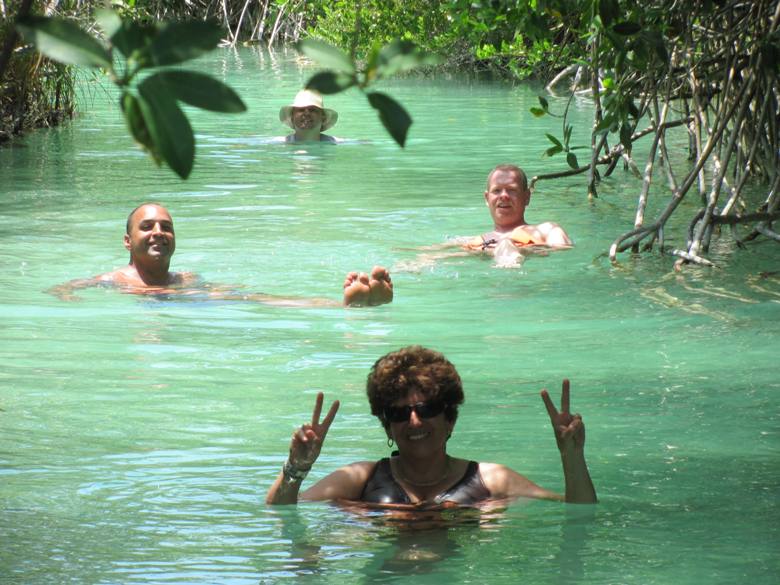A unique biosphere on the Mexican Riviera Maya


DAY 3 — I am floating down a river so clear I can see to the bottom. There are mangroves and sea grass and hardly any people. The water is so refreshing on such a hot day. I don’t have to do anything. The current carries me.
Welcome to Sian Ka’an Biosphere Reserve — the name in Mayan language translates to the Entrance to the Sky — with 1.3 million acres the largest protected area in the Mexican Caribbean that is part of UNESCO’s Man and the Biosphere Program and a UNESCO World Heritage Site that is unique for its diverse geography. It boasts more than 100 mammal species, over 330 bird species and is an important nesting ground for birds as well as endangered sea turtles.
Did I mention that there are also more than 20 archeological sites dating back some 2300 years?
My guide is Antonio Caamol Vitzil who works for Community Tours—a Mayan owned and operated company (www.siankaantours.org) that has begun to offer tours here. There are only two villages in the biosphere including Muyil where Antonio lives with his family and just 300 0ther people.
Thanks to help from the Mexican government and the Fairmont Mayakoba (www.fairmont.com/mayakoba), the Muil community is trying to grow a tourism business by offering eco tours—birding, kayaking, snorkeling, fishing. Soon, there will be a restaurant showcasing local cuisine and a museum about the Mayan culture that continues to this day.
Fairmont Mayakoba has committed to helping the Mayan community preserve their culture through support of Community Tours and other efforts that bring Mayan handicrafts and local honey to the resort, even helping to finance the construction of a bathroom within the biosphere. I think it is terrific that the resort returns all the profits from the handicrafts back to the Mayan communities too.
“We need to develop strategies so that guests can experience the region even when staying at a big hotel,” said Veronica Escobar, a spokesman for the resort.
Vitzil, for his part, wished more large hotels would support their efforts. There are only four of us in this group and I think what an opportunity to see this area and learn about the ancient Mayan culture—and help the community at the same time (the $99 fee, half for kids seems eminently reasonable). Other trips that skip the archeological park but include snorkeling along the reef can cost even less.
Before we had jumped into the river, we’d passed in a small boat through two narrow canals bordered by Mangroves. It is astonishing that one was built by ancient Mayans to facilitate transportation between the inland Mayan cities and the ocean, enabling them to move goods back and forth as well as to go fishing. We stopped at an ancient Mayan military check point.
Our day had started in the jungle and an archeological park. Unlike other Mayan sites, here you can touch and climb to the top of these temples—50 have been uncovered but most are still simply big piles of rubble dating back to 200 BC.
My favorite is the one that is 60 feet high. This is where a fertility god lived, we learn, and women from wealthy families from surrounding Mayan communities would come to touch the palace in the hopes that the sons they would have would grow up to become priests.
It is hot in the jungle and I’m trying to imagine what it must have been like to live here so many thousands of years ago. Muyil, we learn, is a much older community than its far more famous neighbor Tulum and at one time was an important commercial center.
We walk about a half mile through the jungle to the Chunyaxche lagoon, where after a snack of local fruits—pineapple, melon and mango—we board a small boat to make our way through the narrow canals to the river.
On our walk, we pass the Copal tree used for incense and the poisonous Chechen tree whose black sap will burn your skin. (The Mayans discovered another tree provided an antidote to sooth the burns.)
The canals are just three feet deep and so narrow that just one boat can pass through at a time. There are hardly any other people—just us and the birds.
We float for 45 minutes for maybe a half mile. We hate to get out of the water! But we must make our way back to the lagoon for a Mayan lunch that is waiting — ceviche, avocado salad, panyuchos (fried tortillas with black beans, meat and cheese. The ceviche is the best I’ve ever had. It’s made with onion, shrimp ,white fish, cilantro and mango.
We sip wine and talk to Antonio about life in his small village where they still speak in the Mayan dialect. One of the challenges of growing the tourism business, he explains, is that locals must learn English. Still, this is far better than people having to leave the village to find jobs elsewhere.
We end the day with a dip in a Cenote—a fresh water swimming hole that is part of the underground river system that crisscrosses the peninsula.
It is an idyllic spot, we all agree—just us and a few locals splashing around in the water that is colder the deeper you go.
I sit on the edge of the Cenote thinking what a privilege it has been to get a glimpse of Mayan culture. I’m glad that my visit—in however a small way—might have helped the village of Muyil.
I really hate to leave.
Next: Playa del Carmen grows up fast
